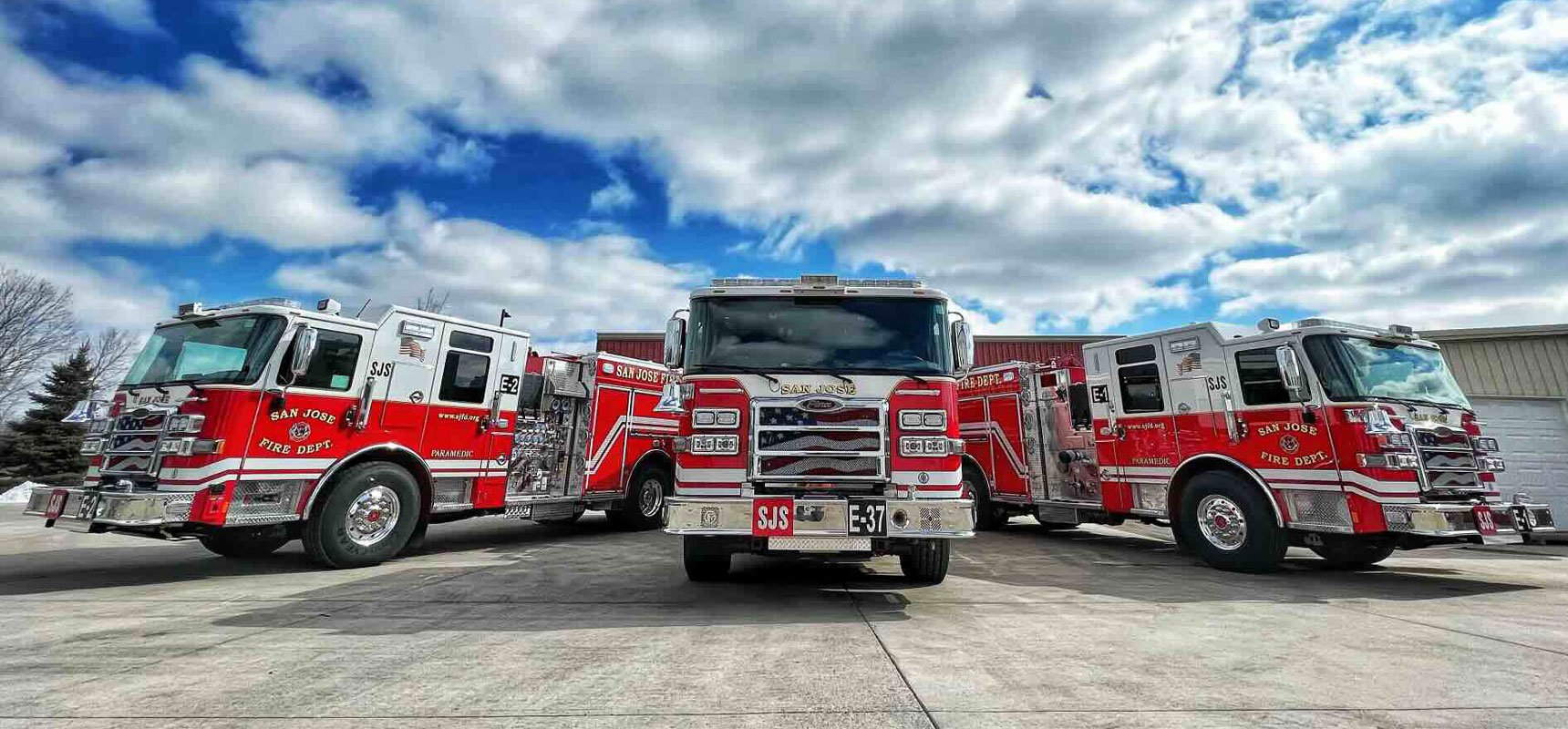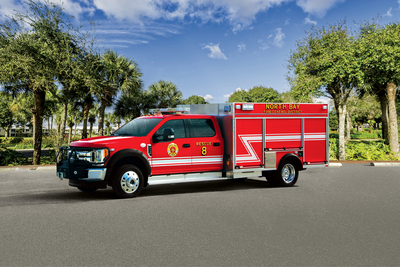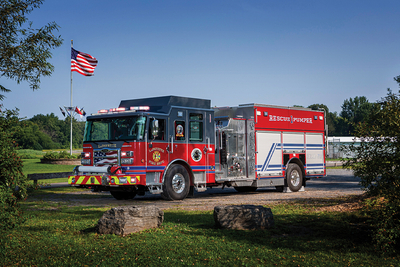 When most people think of a fire truck, they think of a pumper—an emergency response vehicle carrying water and firefighters to put out a fire.
When most people think of a fire truck, they think of a pumper—an emergency response vehicle carrying water and firefighters to put out a fire.
But there’s more to consider.
Below, we review several different types of pumper fire trucks, including National Fire Protection Association specifications, configuration types and what fire department representatives should know as they choose the right option for their needs. This is the ultimate guide to Pierce Manufacturing pumper fire apparatus!
What is A Pumper Fire Truck?
 The National Fire Protection Association (NFPA) states that a pumper fire truck is “[a] fire apparatus with a permanently mounted fire pump of at least 750 gpm (3000 L/min) capacity, water tank and hose body whose primary purpose is to combat structural and associated fires.”
The National Fire Protection Association (NFPA) states that a pumper fire truck is “[a] fire apparatus with a permanently mounted fire pump of at least 750 gpm (3000 L/min) capacity, water tank and hose body whose primary purpose is to combat structural and associated fires.”
In addition, NFPA also requires that pumper fire trucks have a “minimum of 40 cubic feet of enclosed weather-resistant compartmentation that meets the requirements of NFPA.” This is used to store firefighting equipment.
As long as trucks are built to follow NFPA specifications detailed in Chapter 5 of The Standard for Automotive Fire Apparatus, pumpers can vary in length, width, height and added features. Below, we compare several types of pumper fire trucks and outline any additional standards the trucks are required to meet.
Initial Attack or Mini Pumper Fire Apparatus

Initial attack fire apparatus, or mini pumpers, may not look much like a traditional fire truck to most onlookers. Built on a truck chassis, a mini pumper’s mission is often to arrive on scene first to initiate firefighting tasks.
NFPA defines a mini pumper as “fire apparatus with a fire pump of at least 250 gpm (1000 L/min) capacity, water tank, and hose body whose primary purpose is to initiate a fire suppression attack on structural, vehicular, or vegetation fires, and to support associated fire department operations.”
A mini pumper fire truck is well suited in any department. The smaller and more maneuverable design means that a mini pumper can arrive on scene quickly while larger pumper trucks make their way to the fire ground.
Learn more about mini pumpers now.
Rescue Pumper
 A rescue pumper fire truck, as its name implies, is designed to offer both rescue and pumper truck capabilities. The ability to function efficiently in emergency response and structural fires means rescue pumpers can be the primary response vehicle for a fire department.
A rescue pumper fire truck, as its name implies, is designed to offer both rescue and pumper truck capabilities. The ability to function efficiently in emergency response and structural fires means rescue pumpers can be the primary response vehicle for a fire department.
See some examples of rescue pumpers in our new delivery gallery.
Heavy-Duty Rescue Pumper

A Heavy-Duty Rescue Pumper (HDRP) is designed with reinforced strength and built for fire departments looking for a larger truck with more compartment space for equipment storage.
A heavy-duty rescue apparatus offers up to 500 cubic feet of storage space with 800-lb of carrying capacity in each compartment.
Learn more about rescue pumpers and advancements in rescue storage in this blog.
Pumper Tanker

The mission of a pumper tanker can vary based on the needs of the fire department and as result, a pumper tanker can have different classifications from an NFPA standpoint.
A pumper tanker can be classified as a pumper fire apparatus and follow the NFPA guidelines for a pumper.
A pumper tanker or pumper tender can also be a fire truck classified as mobile water supply. Interestingly, modern regional vernacular dictates the name used: the term ‘tanker’ is used on the East coast of the United States, while ‘tender’ is used on the West Coast.
This pumper tanker is primarily used for transporting and delivering water to emergencies to be used by other vehicles or pumper equipment. A pumper tanker carries all the equipment needed for NFPA compliance, and the Pierce Pumper Tanker includes:
- Water tank capacities up to 3,000 gallons.
- A wide array of compartmentation options to store equipment.
- Heavy-duty construction.
There are additional size and configuration options for pumper tankers. A wetside tanker includes a tank that is exposed to the outside with no high side compartments, while a dryside tanker has a tank that is not exposed, with a body constructed around it for added compartment storage. An elliptical tanker is a tanker truck with an elliptical-shaped water tank. The benefit of an elliptical tanker is that it offers a lower weight vehicle with easy maneuverability.
Learn more about tanker fire trucks here.
High-Flow Industrial Pumper
 High-flow industrial pumper apparatus are typically designed to support industrial areas and private companies in the oil and petrochemical industry. High-flow pumpers feature large foam tanks and high water flow rates to support high capacity fire suppression.
High-flow industrial pumper apparatus are typically designed to support industrial areas and private companies in the oil and petrochemical industry. High-flow pumpers feature large foam tanks and high water flow rates to support high capacity fire suppression.
The Pierce High-Flow Industrial Pumper offers water flow rates up to 10,000 gpm. Here are some additional facts about the high-flow industrial pumper:
- It is designed with simple control panels to improve speed and efficiency in emergency response.
- The truck features highly accurate flow meters providing flow data across a broad range of flow rates.
- The apparatus includes a Darley 2ZSM water pump that delivers higher discharge flow rates and additional reach performance.
- The fire truck can be built to include the Husky™ 450 foam system to provide expanded capabilities for the most extreme firefighting conditions. The foam pump has capacities up to 450 gallons per minute and is capable of supporting a 7,500 gpm discharge rate while using a 6-percent foam concentrate.
Learn more about industrial apparatus in our recent blog: Industrial Fire Truck Design, Selection and Use.
Ultra High-Rise Pumper
 As urban buildings reach extraordinary heights, fire truck manufacturers have been challenged to design apparatus to support ultra high-rise fire suppression. Pierce met this challenge with the Ultra High-Rise Pumper (UHRP), specifically created to support urban environments with high-rise and skyscraper buildings.
As urban buildings reach extraordinary heights, fire truck manufacturers have been challenged to design apparatus to support ultra high-rise fire suppression. Pierce met this challenge with the Ultra High-Rise Pumper (UHRP), specifically created to support urban environments with high-rise and skyscraper buildings.
With its first high-rise test UL certified, Pierce’s UHRP features the ability to pump fire
suppression agents up to 1378 feet (420 meters) in height.
The UHRP is built on Pierce custom chassis and uses a high horsepower engine. The apparatus includes a three-stage Waterous CMU/CGV fire pump that can pump up to 2000 gpm.
Learn more about the ultra high-rise pumper now.
Responder Pumper
 A responder pumper is a smaller pumper fire truck designed to deliver value-driven configurations that won’t compromise performance.
A responder pumper is a smaller pumper fire truck designed to deliver value-driven configurations that won’t compromise performance.
With a smaller chassis and maneuverable wheelbase options, the responder pumper fire truck can include up to a 1,250-gallon water tank, room on board for EMS equipment storage and an extended cab with an optional third seat.
Learn more about responder pumper fire trucks now.
Pierce PUC™ Pumper
 The Pierce Ultimate Configuration or PUC™ water pump fire truck design eliminates the pump house and brings the pump forward below the cab. In doing so, the PUC reduces overall vehicular space used for fire suppression and maximizes space for equipment and tool storage.
The Pierce Ultimate Configuration or PUC™ water pump fire truck design eliminates the pump house and brings the pump forward below the cab. In doing so, the PUC reduces overall vehicular space used for fire suppression and maximizes space for equipment and tool storage.
Some of the key benefits of the PUC design include:
- Easier to use with the Sure-Shift pump engagement
- Easier to stay safer by the operator not standing over the hose
- Easier to service with easy access to the plumbing and boots on the ground pump service
- Easier to maneuver with a shorter wheelbase than a traditional pump house
- Easer to store with the jump off compartment on the right side of the vehicle.
The Next Generation PUC water pump and integrated pump transmission provide enhanced flow capabilities up to 2000 gpm and a rugged drive system.
Learn more about the PUC fire truck in our blog: Pierce Ultimate Configuration: 8 Key Benefits for Fire Departments.
BX™ Pumper
 For rural communities and wildland firefighting, Pierce also offers BX™ Pumper fire trucks, which include an aluminum body with high side spatter painted compartments on each side and a 1,250 gpm pump inside a 34" pumphouse. Standards include LED lights, roll-up doors, enclosed ladder storage, wrap-around tail lights and a full width hosebed.
For rural communities and wildland firefighting, Pierce also offers BX™ Pumper fire trucks, which include an aluminum body with high side spatter painted compartments on each side and a 1,250 gpm pump inside a 34" pumphouse. Standards include LED lights, roll-up doors, enclosed ladder storage, wrap-around tail lights and a full width hosebed.
Learn more about BX pumper trucks now.
Finding the right pumper apparatus to match your fire department’s needs can be a difficult task, but hopefully, this overview with examples provided you with several options to consider.
What design features of your pumper fire truck would you recommend to other fire departments? Let us know in the comments